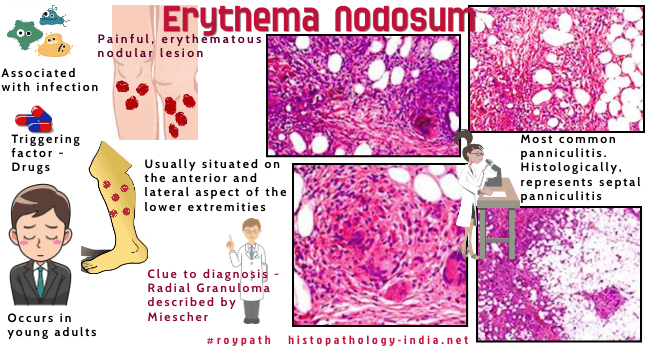|

Custom Search
|
|
Infectious Disease Online Pathology of Erythema Nodosum
|

|
Erythema nodosum is an acute, nodular, erythematous eruption
that usually is limited to the extensor aspects of the lower legs.
Erythema nodosum may occur with or without another medical condition.
Conditions that are linked with erythema nodosum include drugs (birth
control pills, estrogens), strep throat, Cat scratch disease, fungal
diseases, infectious mononucleosis, sarcoidosis, Behcet's disease,
inflammatory bowel diseases (Crohn's disease and ulcerative colitis), and
normal pregnancy.
|
|
Erythema nodosum is a disease
characterized by painful , erythematous nodular lesions. It is the most common panniculitis and histologically represents the prototype of a septal panniculitis. Site: Situated on the anterior and lateral aspect of the lower extremities and rarely on the arms, trunk, and calves, and on the neck and face. Age: Usually occurs in young adults. Cases have been reported in children and in elderly patients. Pathogenesis: It is not known and may be due to allergic response to infection or systemic disease. Erythema nodosum is associated with the following conditions: - Infection : Streptococcal ;Meningococccal ;Campylobacter ; Salmonella ; Histoplasma ; Mycobacterial ; Dermatophyte ; Yernia. - Sarcoidosis (2nd most common cause) - Inflammatory bowel disease ; Behcet disease ; Sweet's disease ; Carcinoma ; lymphoma ; leukemia. Other triggering factors include drugs (Example: Sulphonamides ; penicillin ; oral contraceptive) and radiotherapy.
|
|
|


